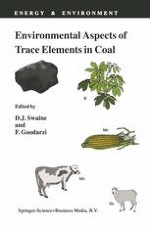1995 | OriginalPaper | Chapter
The Formation, Composition and Utilisation of Flyash
Author : D. J. Swaine
Published in: Environmental Aspects of Trace Elements in Coal
Publisher: Springer Netherlands
Included in: Professional Book Archive
Activate our intelligent search to find suitable subject content or patents.
Select sections of text to find matching patents with Artificial Intelligence. powered by
Select sections of text to find additional relevant content using AI-assisted search. powered by
Much has been written about flyash probably mainly because it is the most important by-product of the combustion of coal. During and after combustion, trace elements in the coal are redistributed into the vapour phase, bottom ash and flyash (Figure 10.1), the latter being the ultimate prime site for most trace elements. Some of the inorganic products from the decomposition of the mineral matter remain in the boiler where they flow down and are removed as bottom ash. Most of the particulate matter (flyash) is swept along with the combustion gases and ultimately removed very efficiently by particle-attenuation devices (electrostatic precipitators; fabric filters — Chapter 8). However, most of the Cl, Hg and F and small proportions of B and Se tend to be emitted with the stack gases (Chapter 7) together with some fine flyash particles which carry trace elements to the atmosphere (Chapter 10). As expected, trace elements in coal (Chapter 2) are found enhanced in flyash by a factor related to the ash yield of the coal. For dry bottom furnaces, 100 t coal yields an amount of flyash equal to about 0.8 times the % mineral matter which is close to 0.8 times the % ash yield at about 800°C. The composition of flyash depends on several factors including the composition of the coal, the furnace configuration, conditions during combustion, the efficiency of particle attenuation and the point of collection of the sample. These variables give rise to wide ranges of concentration of trace elements.
